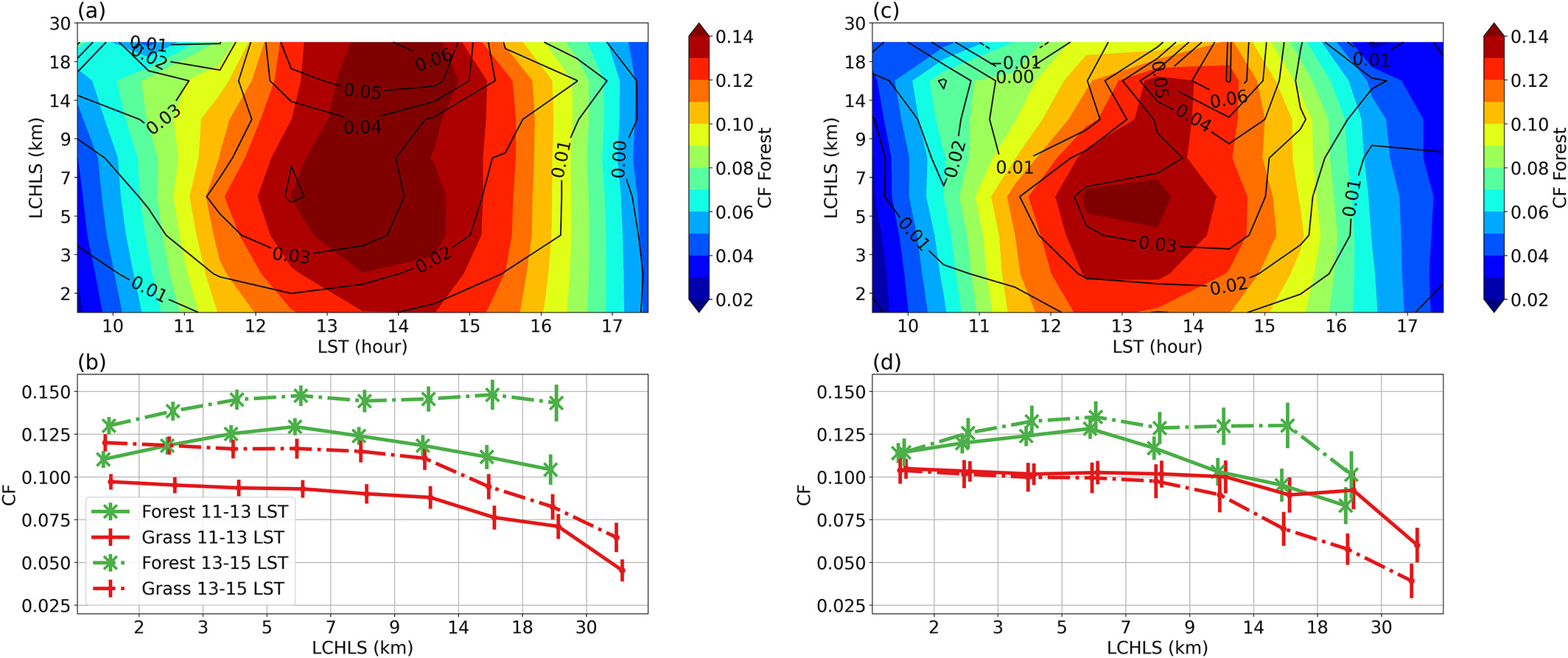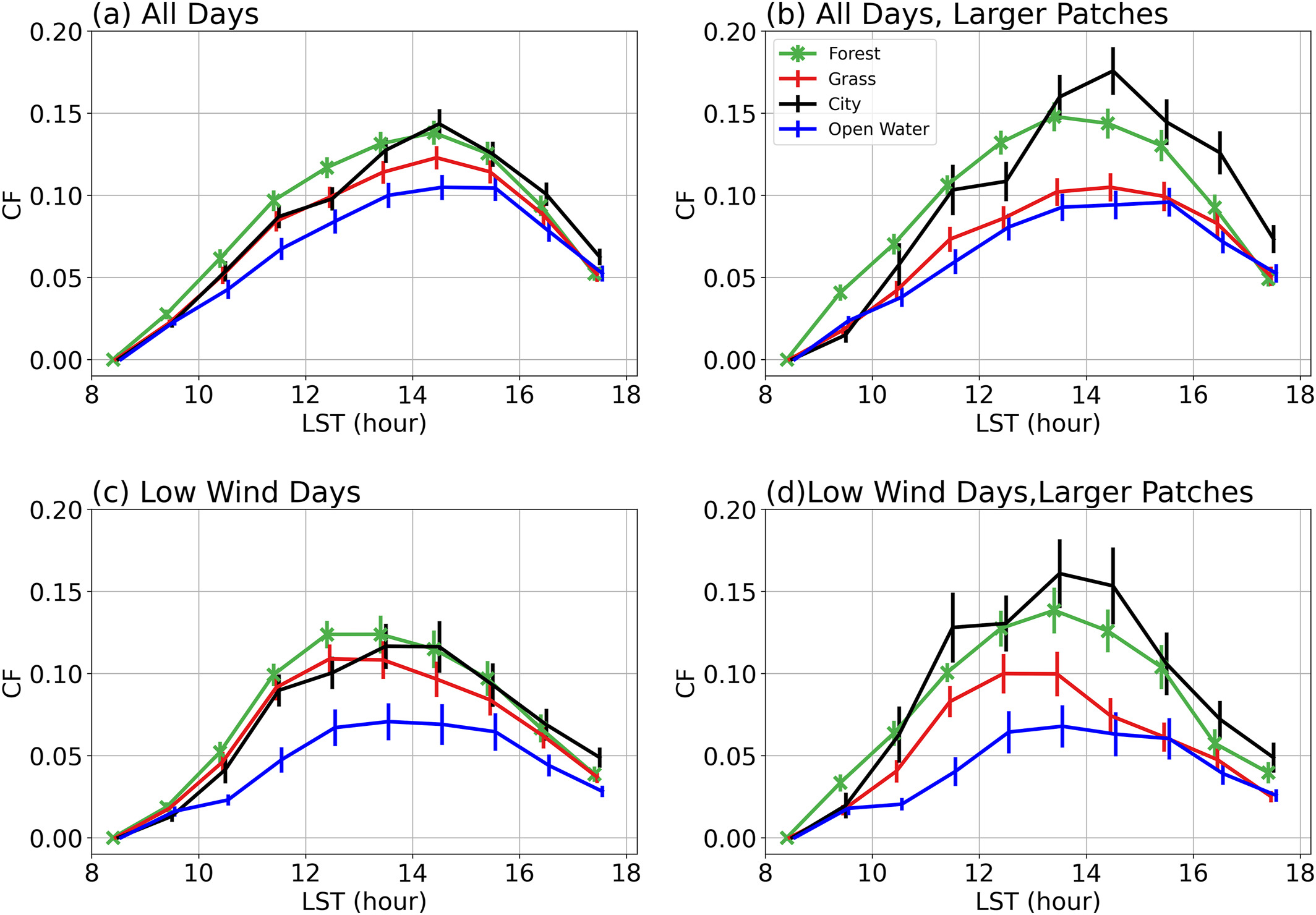How do land cover and its heterogeneity length scales affect formation of shallow cumulus?
Submitter
Zhang, Yunyan — Lawrence Livermore National Laboratory
Area of Research
Cloud Processes
Journal Reference
Tian J, Y Zhang, S Klein, R Ӧktem, and L Wang. 2022. "How does land cover and its heterogeneity length scales affect the formation of summertime shallow cumulus clouds in observations from the US Southern Great Plains?" Geophysical Research Letters, 49(7), e2021GL097070, 10.1029/2021GL097070.
Science

Figure 2. (a) Cloud fraction (CF) over forest as a function of local time and land cover heterogeneity length scale (LCHLS). Solid black contour lines represent the CF difference between forest and grassland. (b) Mean CFs over forest (green with cross) and grassland (red) during 11–13 local solar time (LST) (solid line) and 13–15 LST (dashed dot line). The length of the vertical bars denotes two standard errors of 15-min mean CFs in each LCHSL bin. (c and d) are the same as (a and b) except for low-wind cases. From journal.

Figure 1. Diurnal evolutions of (a) cloud fraction over forest (green with cross), grassland (dark red), city (black), and open water (dark blue) in the analysis domain of SGP. The length of the vertical bars denotes two standard errors of samples. (b) same as in (a) except for larger patches (>5 km). (c and d) are the same as (a and b) except for low-wind days. From journal.
Continental shallow cumulus (ShCu) clouds are tightly coupled with the underlying heterogenous land surface. In most climate models, systematic biases in the surface energy balance and precipitation are often attributed to the parameterized processes associated with ShCu, e.g., the interactions among land surface, atmospheric boundary layer, and clouds. Observational studies of ShCu over heterogenous land surface are greatly needed to develop theoretical understandings and improve parameterizations for models.
Impact
Using high-temporal-and-spatial-resolution data, this study provides new observational evidence of the heterogenous land cover effect on ShCu formation. We found that ShCu occurrence differentiates among land cover types, and that ShCu occurrence depends on the heterogeneity length scale of land covers. Our results suggest that, in climate models, the sub-grid-scale interactions between land surface, atmospheric boundary layer, and clouds need to be carefully considered to improve the model representations of convection processes over land at diurnal scales.
Summary
This study takes advantage of the newly developed GOES-16 ShCu data (Tian et al. 2021) with high-spatial-resolution land cover data to investigate the impact of land cover heterogeneity on summertime ShCu cloud occurrence over the Southern Great Plains (SGP). We found that, during late summer, ShCu occurs over cities the most frequently and over open waters the least frequently, and more often over forest than over grassland. The preferential occurrence of ShCu over forest relative to grassland is consistent with surface ARM measurements showing larger sensible and latent heat fluxes over forests. This preferential occurrence also varies with the length scales of land patches, with the largest cloud occurrence difference shifting from smaller length scales (< 9 km) during midday to larger scales (>9 km) in the early afternoon. Consistent with theory, these signals are more pronounced under low-wind conditions. The preferential length scale shift with time suggests the existence of secondary circulations that strengthen and promote convergence over larger spatial scales as the differential land surface heating intensifies. The framework and data developed in this study can be further applied to investigate shallow-to-deep convective cloud transition processes and their interactions with land covers.
Keep up with the Atmospheric Observer
Updates on ARM news, events, and opportunities delivered to your inbox
ARM User Profile
ARM welcomes users from all institutions and nations. A free ARM user account is needed to access ARM data.


















